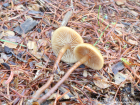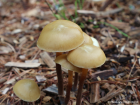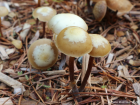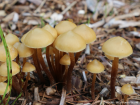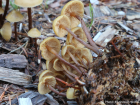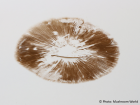Cap initially convex but becomes broadly convex or nearly flat over time, with margins that are striated. It is hygrophanous which means it is changing colour as it dries out. It starts as tan-brown at the centre, fading to buff-brown, and in older specimens, it turns cream to white. Gills adnexed or adnate, crowded, initially dingy pale-tan, and in aging specimens, they become dull medium-brown. Stem equal to narrowed at the apex, oval in cross-section, sometimes longitudinally grooved, hollow in age, often with a basal bend. The surface of apex is pruinose, pale tan, lower portion glabrous to sparsely fibrillose and dingy vinaceous-brown. The partial veil is fibrillose-membranous, pallid, and evanescent, leaving fragments on the young cap and a thin fibrillose zone high on the stipe. Spore print medium-brown.
Microscopic Features: The spores measure approximately 5.5-7.0 µm in length and 3.5-4.0 µm in width. They have an elliptical shape, a smooth surface, and a moderately thick wall. The apical end is flattened and features a well-defined germ pore, while the hilar appendage is not distinct.
Similar species include Galerina marginata (Deadly Galerina).
Kuehneromyces lignicola on the mykoweb.com Web site.
Many mushrooms are poisonous, and some can be lethally toxic. Distinguishing between edible and poisonous mushrooms can be very challenging. Therefore, we strongly advise against consuming wild mushrooms. This website does not contain any information about the edibility or toxicity of mushrooms.
Although efforts have been made to ensure accuracy on this website, the information may contain errors and omissions. Therefore, all content provided is for educational and informational purposes only and should not be relied upon or used as a basis for consuming any plants or mushrooms.
External links are provided for reference only. We do not endorse or take responsibility for the content, advice, or products found on these sites or in any advertisements shown on this website.

